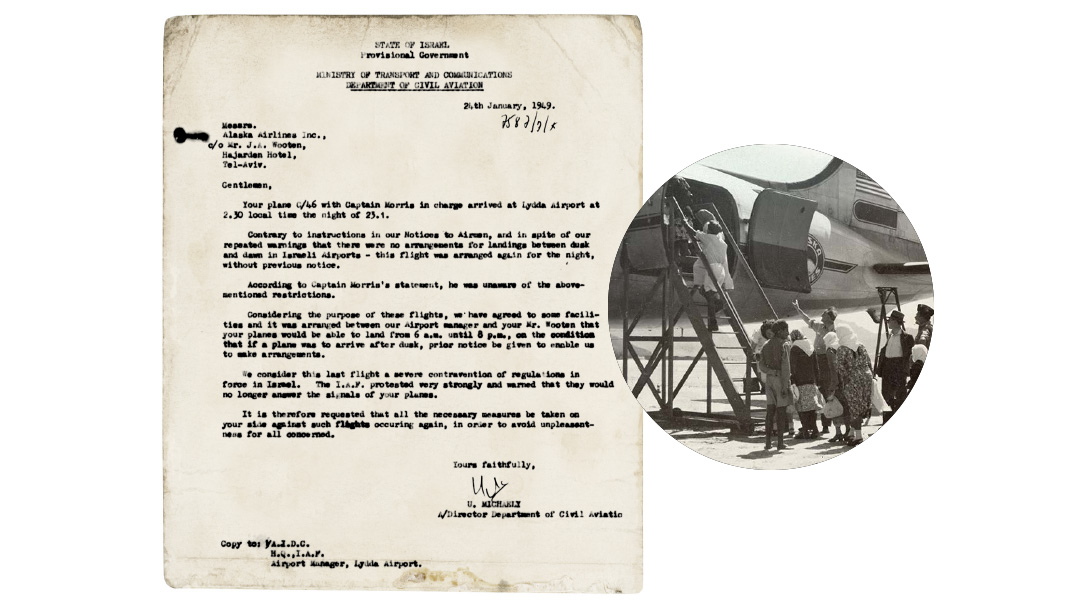Eagles from Alaska
| May 3, 2022A daring air rescue was proposed, Alaska Airlines was contacted and Operation “On Wings of Eagles” was launched

Title: Eagles from Alaska
Location: Aden, Yemen
Document: Letter from the Israeli Civil Aviation Authority
Time: 1949-50
IN his Anchorage office, Alaska Airlines president James Wooten pondered how to utilize the new fleet of DC-4 and C-46 transport aircraft he had purchased from US military surplus after World War II. He had recently used several planes to ship cargo during the 1948 Berlin Airlift. But the adventures were just beginning.
Jewish immigrants had trickled steadily out of the ancient community in Yemen to Eretz Yisrael since the middle of the 19th century, often making the long desert trek on foot with great sacrifice. When Yemen closed its borders in May 1945, many Jews there had already left their homes and were refugees in the port city of Aden awaiting transport out. The Joint Distribution Committee established a temporary holding facility known as “Machaneh Geulah.”
With the declaration of the State of Israel, violence erupted all over the region, and the Yemenite Jewish population was targeted in pogroms. This increased the number of Jewish refugees plying the desert roads leading to Aden. Something had to be done to get them to Israel. While most immigrants during this perilous time arrived by boat, the Egyptian Navy patrolling the Gulf of Aqaba precluded that possibility. A daring air rescue was proposed, Alaska Airlines was contacted and Operation “On Wings of Eagles” was launched.
The airlift began in December 1948 and ended on September 19, 1950, with close to 450 charter flights flown on Alaska Airlines, many of which were piloted by Wooten himself. Alaska Airlines evacuated approximately 49,000 Yemenite Jews on a harrowing escape route from Aden to Tel Aviv. In the initial stage, Jewish lives were endangered, and flights went for seven days straight.
Elgen Long was the navigator for the Alaska flights. “We’d take turns sleeping,” he recalled. “I’d rest and then the captain would wake me up when he needed another navigational reading.”
Navigating the flights was a challenge, as they had to be careful to avoid enemy airspace. Running low on fuel, the planes had to fly up the Red Sea, avoiding both Egypt and Saudi Arabia. Oftentimes dodging enemy fire, and flying low to avoid detection, they landed in Tel Aviv in the midst of a war zone. They would immediately take off and refuel in Cyprus before returning to Aden.
Long recalled being told: “‘They’re sick and we don’t have the people to take care of them. They’re hungry, but we don’t have food to feed them. They need clothes, but we have none to give them. We can’t protect them — we don’t have the manpower. They are fair game for the local Arabs. There have been pogroms going on — over 80 have been killed already. Get them out of here as quickly as you can.’ ”
Seats were removed from the cramped aircraft to accommodate up to 100 refugees on each flight. Having arrived with their meager possessions after traveling barefoot through the desert, most members of this ancient Jewish community had never seen an airplane before, let alone flown on one. Understandably many were hesitant to board. The Yemenite Jews believed that their return to the Holy Land would come “on wings of eagles,” in fulfillment of the prophecy. Alaska Airlines embodied the metaphor and returned them to their homeland.
Long also recalled the Yemenite Jews’ hesitation regarding flying on Shabbos. “They didn’t want to fly on the Sabbath, but their Rabbi told them it was okay because this was a life and death situation.”
Alaska Airlines proudly executed the mission, despite all the accompanying challenges, without a single loss of life. Due to the sensitive security situation, details of Operation “On Wings of Eagles” remained secret for decades. As the exhibit shows, even the Israeli civil aviation authorities didn’t quite know what was happening. Only in recent years has the airline been recognized for its historic role in evacuating of Jews from Yemen.
The Long Life of Elgen Long
In 2017, Elgen Long, then the last surviving member of the Alaska Airlines crew, was invited to Israel. Before embarking on the trip, he was asked which holy sites he would like to visit and which politicians he would like to meet. His answer was simple: “I would love to see the people who came with me on those planes to Israel.” And saw he did. During several community gatherings in the center and south of Israel, hundreds of people showed up to thank Elgen for his heroism. Many arrived with their children and grandchildren to show their gratitude to the man who had helped save them.
Shanghai Saviors
As the People’s Liberation Army closed in on Shanghai during the final stages of the Chinese Civil War in the spring of 1949, Alaska Airlines commandeered several aircraft to airlift out the last of the Jewish community, including those who had sought refuge in the Far East during the war. Immediately following the Shanghai rescue operation, the Yemen operation began.
(Originally featured in Mishpacha, Issue 909)
Oops! We could not locate your form.






